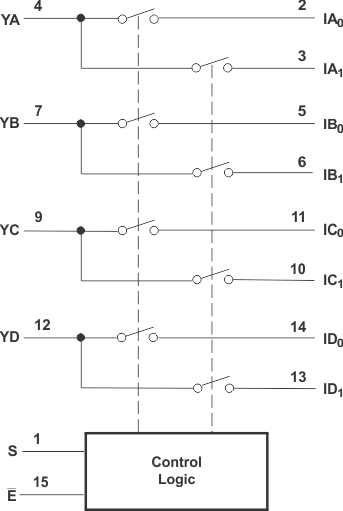SCDS176B SEPTEMBER 2004 – October 2019 TS3L110
PRODUCTION DATA.
- 1 Features
- 2 Applications
- 3 Description
- 4 Revision History
- 5 Pin Configuration and Functions
- 6 Specifications
- 7 Parameter Measurement Information
- 8 Detailed Description
- 9 Application and Implementation
- 10Power Supply Recommendations
- 11Layout
- 12Device and Documentation Support
- 13Mechanical, Packaging, and Orderable Information
Package Options
Refer to the PDF data sheet for device specific package drawings
Mechanical Data (Package|Pins)
- PW|16
- DBQ|16
- RGY|16
- D|16
- DGV|16
Thermal pad, mechanical data (Package|Pins)
- RGY|16
Orderable Information
3 Description
The TS3L110 local area network (LAN) switch is a 4-bit 1-of-2 multiplexer/demultiplexer with a single switch-enable (E) input. When E is low, the switch is enabled, and the I port is connected to the Y port. When E is high, the switch is disabled, and the high-impedance state exists between the I and Y ports. The select (S) input controls the data path of the multiplexer/demultiplexer.
The TS3L110 device can be used to replace mechanical relays in LAN applications. This device has low and flat ON-state resistance (ron), wide bandwidth, and low crosstalk, making it suitable for 10/100 Base-T and various other LAN applications. The TS3L110 device can be used to route signals from a 10/100 Base-T Ethernet transceiver to the RJ-45 LAN connectors in laptops or in docking stations. This device is designed for low channel-to-channel skew and low crosstalk.
This device is fully specified for partial-power-down applications using Ioff. The Ioff feature ensures that damaging current does not backflow through the device when it is powered down. The device has isolation during power off.
To ensure the high-impedance state during power up or power down, E should be tied to VCC through a pullup resistor; the minimum value of the resistor is determined by the current-sinking capability of the driver.
Device Information(1)
| PART NUMBER | PACKAGE | BODY SIZE (NOM) |
|---|---|---|
| TS3L110 | SOIC (D) 16 | 9.90 mm x 3.91 mm |
| SSOP (DBQ) 16 | 4.90 mm x 3.90 mm | |
| TVSOP (DGV) 16 | 3.60 mm x 4.40 mm | |
| TSSOP (PW) 16 | 5.00 mm x 4.40 mm | |
| VQFN (RGV) 16 | 4.00 mm x 4.00 mm |
- For all available packages, see the orderable addendum at the end of the data sheet.
Logic Diagram (Positive Logic)
